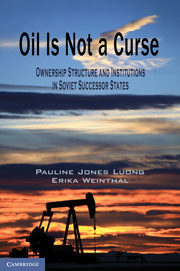
-
Select format
-
- Publisher:
- Cambridge University Press
- Publication date:
- June 2012
- August 2010
- ISBN:
- 9780511779435
- 9780521765770
- 9780521148085
- Dimensions:
- (234 x 156 mm)
- Weight & Pages:
- 0.74kg, 446 Pages
- Dimensions:
- (234 x 156 mm)
- Weight & Pages:
- 0.61kg, 446 Pages
You may already have access via personal or institutional login
Book description
This book makes two central claims: first, that mineral-rich states are cursed not by their wealth but, rather, by the ownership structure they choose to manage their mineral wealth and second, that weak institutions are not inevitable in mineral-rich states. Each represents a significant departure from the conventional resource curse literature, which has treated ownership structure as a constant across time and space and has presumed that mineral-rich countries are incapable of either building or sustaining strong institutions - particularly fiscal regimes. The experience of the five petroleum-rich Soviet successor states (Azerbaijan, Kazakhstan, the Russian Federation, Turkmenistan, and Uzbekistan) provides a clear challenge to both of these assumptions. Their respective developmental trajectories since independence demonstrate not only that ownership structure can vary even across countries that share the same institutional legacy but also that this variation helps to explain the divergence in their subsequent fiscal regimes.
Reviews
'The author's concluding chapter makes a reasonably, if not overwhelmingly persuasive case about why the resource curse hypothesis is a myth.'
Gaurav Sharma Source: oilholicssynonymous.com
Contents
Metrics
Altmetric attention score
Full text views
Full text views help Loading metrics...
Loading metrics...
* Views captured on Cambridge Core between #date#. This data will be updated every 24 hours.
Usage data cannot currently be displayed.
Accessibility standard: Unknown
Why this information is here
This section outlines the accessibility features of this content - including support for screen readers, full keyboard navigation and high-contrast display options. This may not be relevant for you.
Accessibility Information
Accessibility compliance for the PDF of this book is currently unknown and may be updated in the future.


